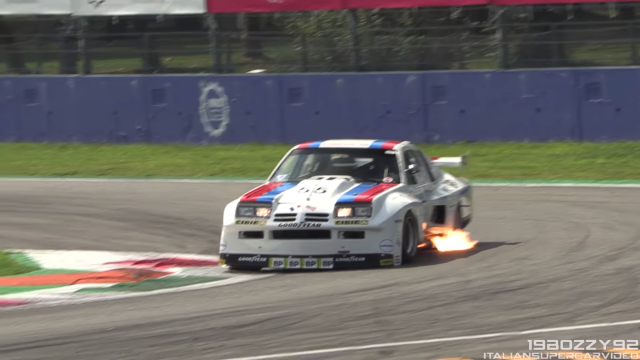This is a Chevy Monza, one of the objectively shittiest cars America has ever produced. But this Monza is different, because it is a power-shifting, howling, monster of a race car better than any sense of reason would have it.
In America, we’re fairly used to a general breakdown between fast cars and bad cars. The cars that are fast are almost all, well, cars that are good. A Porsche Macan GTS is quick, but it is also comfortable, packed with tech, and lined with leather. Pretty much all of the fast cars on the market today are, well, pretty nice. We don’t have complete hunks of shit on the road that have gigantic engines in them, and I think that’s true even of the Dodge Challenger around the corner from you with the licence plate reading “SKRRRRT” or “IDOCRMS.”
Even our racecars are generally drawn from the upper ends of the auto market. Le Mans’ GT categories were filled with Aston Martins, Ferraris, and Porsches. We are in an age of Bentleys racing BMWs, and that’s about it.
In the 1970s, this was not the case.
We were blessed with DeKon Monzas, humble American rear-drive economy cars that were completely and utterly reworked until they were as fast as turbo Porsches. How did they do this? Giant wings, huge tires, and roaring V8s worthy of Darlington.
That’s rude, actually. The DeKon Monzas weren’t just shitboxes with big gear; they were sophisticated machines for their day, as DeKon resource scharch.org explains in a history of these legendary racers:
DeKon was the most successful and recognised builder of the H07 silhouette Monza GT racecars. The DeKon modified Chevrolet Monza won the IMSA GT championships in 1976, 1977 and 1978.
[…]
GM started producing Monzas near the close of 1974 and DeKon received them as complete cars. They would tear down and reconstruct them to the needs and specifications of their customer’s.
The Dekon Monza featured a tubular frame chassis, an overall weight of about 1,089 kg, and over [447 kW] from a fuel-injected V-8 engine. The cars were very fast and competitive, thanks in part to their excellent 50/50 weight distribution.
Engines used were heavily modified Chevrolet 5.7-6.0 L V8 small-blocks, normally aspirated, some using four Weber (2V) downdraft carburetion. They developed as much as [484 kW]. The car’s lightweight, high horsepower combination was a formidable competitor in IMSA and other racing series. After some teething problems the DeKon Monza of Al Holbert won the IMSA GT Championship in 1976 and 1977.
A sophisticated chassis, a high-power engine, all wrapped up in the body of, well, one of America’s saddest attempts at an economy car.
What was so bad about the Monza? Well, it came out in the mid-1970s, as American auto companies were busily trying to figure out just how cheaply they could make a car and get people to still buy them. The Monza “carried the triple whammy of lifeless performance, sketchy build quality, and badge engineering run amok,” as Hagerty put it in a retrospective on the car, which was neither very practical nor very well-made. They were also slow as shit, which makes the race car versions extra charming. From Hagerty:
GM had originally planned the cars to use a Wankel rotary engine it was developing but cancelled that program. Instead, the H-bodies used a variety of anemic corporate engines, including the Vega four-cylinder (later replaced by the Pontiac Iron Duke), Buick V-6, and Chevy small block V-8. Transmissions included four-speed stick, three-speed automatic, and later a five-speed option for four-cylinder and V-6 models.
The Monza’s optional 262-cubic-inch V-8 with two-barrel carburetor made a pitiful [86 kW]. California buyers got a 350 instead, with a still-dismal [93 kW] but more torque. In Road & Track’s hands, the 262 Monza crawled from 0–97 km/h in 13.4 seconds and sauntered through the quarter mile in 18.5 seconds at 117 km/h. A 140-horse 5.0-litre (305-cu-in) version livened up performance in 1977 but was dropped after 1979. Most H-body buyers were focused on fuel economy.
Listen to this Monza (the chevy) absolutely screaming around Monza (the race track) and you’ll get what I mean. It is wailing at the high end of its rev limit, and down at the bottom, it sounds like a rock crushing machine. Good shit.
This is all to say that we should recognise the spirit of excellence that lives in all cars, even the shittiest ones. An excellent message, and an important one.
